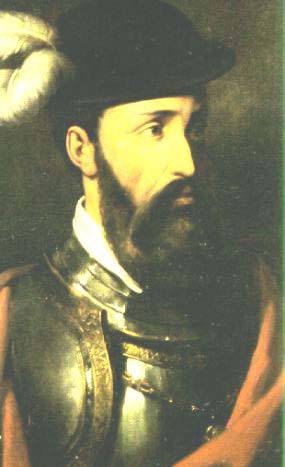 |
usa | world | animals | vocabulary | health | science | math | history |
Spanish Colonization
Spanish colonization of the Americas began with the arrival in the Americas of Christopher Columbus in 1492. He had been searching for a new route to the Asian Indies and was convinced he had found it. Columbus was made governor of the new territories and made several more journeys across the Atlantic Ocean. He profited from the labour of native slaves, whom he forced to mine gold; he also attempted to sell some slaves to Spain. While generally regarded as an excellent navigator, he was a poor administrator and was stripped of the governorship in 1500.
Early settlements by the Spanish were on the islands of the Caribbean. On his fourth and final voyage in 1502 Columbus encountered a large canoe off the coast of what is now Honduras filled with trade goods. He boarded the canoe and rifled through the cargo which included cacao beans, copper and flint axes, copper bells, pottery, and colorful cotton garments. He took one prisoner and what he wanted from the cargo and let the canoe continue. This was the first contact of the Spanish with the civilizations of Central America.

Francisco Pizarro, conqueror of the Inca Empire
The Treaty of Tordesillas was an attempt to solve the disputes with the Portuguese colonizers. It split the mostly unknown New World into two spheres of influence; however, when it was fully charted almost all the land fell in the Spanish sphere.
It was 1517 before another expedition from Cuba visited Central America landing on the coast of the Yucatán in search of slaves. This was followed by a phase of conquest: The Spaniards (just having finished a war against the Muslims in the Iberian peninsula) replaced the American local oligarchies and imposed a new religion: Christianity.
European diseases (smallpox, influenza, measles and typhus) to which the native populations had no resistance, and cruel systems of forced labor, such as the infamous haciendas and mining industry's mita), decimated the American population under Spanish control. After this, african slaves, who had developed immunities to these diseases, were quickly brought in to replace them.
The Spaniards were committed to converting their American subjects to Christianity, and were quick to purge any native cultural practices that hindered this end. However, most initial attempts at this were only partially successful, as American groups simply blended Catholicism with their traditional beliefs. On the other hand, the Spaniards did not impose their language to the degree they did their religion, and the Catholic Church's evangelization in Quechua, Nahuatl and Guarani actually contributed to the expansion of these American languages, equipping them with writing systems.
Eventually the Natives and the Spaniards interbred, forming a Mestizo class. These and the original Americans were often forced to pay unfair taxes to the Spanish government and were punished harshly for disobeying their laws. Many native artworks were considered pagan idols and destroyed by Spanish explorers. This included the many gold and silver sculptures found in the Americas, which were melted down before transport to Europe.
The precious metals were subjected to the Quinto Real tax, a fifth of everything seized. The silver of America (especially the mines of Zacatecas and Potosí) went to pay the enormous debt brought by the wars against the Reformation led by the Spanish kings.
Soon the exclusive of commerce between Europe and America was conceded to Seville (later to Cádiz).
During the Peninsula War, several assemblies were established by the creole to rule the lands in the name of Ferdinand VII of Spain. This experience of self-government and the influence of Liberalism and the ideas of the French and American Revolutions brought the struggle for independence, led by the Libertadores. The colonies freed themselves, often with help from the British empire, which aimed to trade without the Spanish monopoly.
Still, the early 20th century saw a stream of immigration of poor people and political exiles from Spain to the former colonies, especially Cuba, Mexico and Argentina. After the 1970s, the flow was inverted.
In the 1990s, Spanish companies like Repsol and Telefonica invested in South America, often buying privatized companies.
Currently, the Iberoamerican countries and Spain and Portugal have organized themselves as the Comunidad Iberoamericana de Naciones.
This article is licensed under the GNU Free Documentation License. It uses material from the Wikipedia article "Spanish colonization".